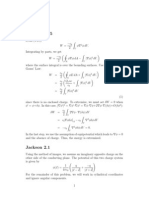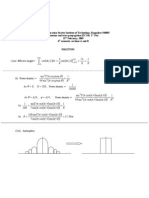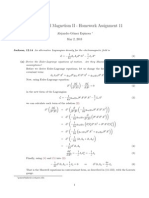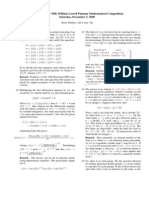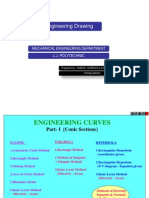Solution For Chapter 24
Solution For Chapter 24
Uploaded by
Sveti JeronimCopyright:
Available Formats
Solution For Chapter 24
Solution For Chapter 24
Uploaded by
Sveti JeronimOriginal Title
Copyright
Available Formats
Share this document
Did you find this document useful?
Is this content inappropriate?
Copyright:
Available Formats
Solution For Chapter 24
Solution For Chapter 24
Uploaded by
Sveti JeronimCopyright:
Available Formats
Solution for Chapter 24
(compiled by Xinkai Wu)
Exercise 24.4 Constant of geodesic motion in a spacetime with symmetry
[Alexander Putilin/99]
(a) Geodesic equation
p
p = 0, i.e.
p
p
;
= 0
(p
,
)p
=
dx
d
p
=
dp
= 0
which gives
dp
d
=
1
2
(g
,
+ g
,
g
,
)p
where in the brackets the rst and the third terms are antisymmetric over ()
so their contraction with the symmetric tensor p
is zero. Thus
dp
d
=
1
2
g
,
p
Take to be A and using g
,A
= 0, we nd
dp
A
d
= 0
namely p
A
is a constant of motion.
(b) Let x
j
(t) be the trajectory of a particle. Its proper time is
d
2
= ds
2
= dt
2
_
1 + 2 (
jk
+ h
jk
)v
j
v
k
= dt
2
(1 + 2
jk
v
j
v
k
+ O(
v
4
c
4
))
thus
d = dt
_
1 + 2 v
2
= dt(1 +
1
2
v
2
)
where we have omitted terms of order v
4
/c
4
(i.e. ||
2
). The 4-velocity is given
by
u
=
dx
d
=
dx
dt(1 +
1
2
v
2
)
=
dx
dt
(1 +
1
2
v
2
)
1
thus in particular u
0
= 1 +
1
2
v
2
.
4-momentum: p
= mu
, and in particular p
0
= mu
0
= m(1 +
1
2
v
2
).
And the conserved quantity is then given by
p
t
= g
0
p
= g
00
p
0
= (1 + 2)m(1 +
1
2
v
2
)
= m(m +
1
2
mv
2
)
we see that p
t
is indeed the non-relativistic energy of a particle aside from an
additive constant m and an overall minus sign.
Exercise 24.5 Action Principle for Geodesic Motion [Xinkai Wu/00]
The action is given by:
S[x
()] =
_
1
0
(g
dx
d
dx
d
)
1/2
d
S =
_
1
0
(g
dx
d
dx
d
)
1/2
d
=
_
1
0
1
2
(g
dx
d
dx
d
)
1/2
(g
dx
d
dx
d
)d
=
_
1
0
1
2
(g
dx
d
dx
d
)
1/2
{
g
x
x
dx
d
dx
d
+g
dx
d
dx
d
+g
dx
d
dx
d
}d
(by renaming , and noticing g
= g
, we get:)
=
_
1
0
1
2
(g
dx
d
dx
d
)
1/2
{
g
x
x
dx
d
dx
d
+ 2g
dx
d
dx
d
}d
Integrating the 2nd term in {...}by parts, we nd, after renaming some
indices:
S =
_
1
0
(g
dx
d
dx
d
)
1/2
{g
d
2
x
d
2
+
g
x
dx
d
dx
d
1
2
g
x
dx
d
dx
d
d ln(g
dx
d
dx
d
)
1/2
d
g
dx
d
}x
d
Thus S = 0 if and only if
g
d
2
x
d
2
+
g
x
dx
d
dx
d
1
2
g
x
dx
d
dx
d
d ln(g
dx
d
dx
d
)
1/2
d
g
dx
d
= 0
Contracting both sides with g
, we get
d
2
x
d
2
+
1
2
g
{2
g
x
dx
d
dx
d
g
x
dx
d
dx
d
}
d ln(g
dx
d
dx
d
)
1/2
d
dx
d
= 0
By renaming for the rst term in {..}, the above equation becomes
d
2
x
d
2
+
1
2
g
{
g
x
+
g
x
g
x
}
dx
d
dx
d
d ln(g
dx
d
dx
d
)
1/2
d
dx
d
= 0
which is just, using the expression for the Christoel symbols,
d
2
x
d
2
+
dx
d
dx
d
d ln(g
dx
d
dx
d
)
1/2
d
dx
d
= 0
Now lets reparametrize the world line, s(), then the equation becomes,
(
d
2
x
ds
2
+
dx
ds
dx
ds
)(
ds
d
)
2
+
dx
ds
[
d
2
s
d
2
d ln(g
dx
d
dx
d
)
1/2
d
ds
d
] = 0
Integrating [...] twice we readily nd that [..] vanishes for
s =
_
A(g
dx
d
dx
d
)
1/2
d + B, where A and B are arbitrary constants.
After this reparametrization, we get the familiar geodesic equation:
d
2
x
ds
2
+
dx
ds
dx
ds
= 0
Exercise 24.7 Orders of magnitude of the radius of curvature [Alexander
Putilin/99]
2
Eq. (24.43) tells us that, if a system has characteristic mass M and charac-
teristic length R, order of magnitude estimate gives,
1
R
2
GM
R
3
where R is the radius of curvature
R
_
R
3
M
in units G = c = 1
1. near earths surfae: R R
6.4 10
6
m (earths radius), M M
4.4mm (earths mass), and R 2.4 10
11
m 1 astronomical unit 1AU.
2. near suns surface: R R
sun
7 10
8
m, M M
sun
1.5km, and
R 5 10
11
m 1AU.
3. near the surface of a white-dwarf star: R 5000km, M M
sun
1.5km,
and R 3 10
8
m
1
2
(sun radius).
4. near the surface of a neutron star: R 10km, M M
sun
3km, and
R 20km.
5. near the surface of a one-solar-mass black hole: M M
sun
1.5km,
R 2M 3km, and R 4km.
6. in intergalactic space: R 10(galaxy diameter) 10
6
light-year,
M (galaxy mass) 0.03 light-year (for Milky way), and R 610
9
light-years
Hubble Distance.
Exercise 24.8 Components of Riemann in an arbitrary basis [Xinkai Wu/02]
p
;
p
;
= R
we have
p
;
= (p
;
)
;
= (p
,
+ p
)
;
= (p
,
+ p
)
,
+
(p
,
+ p
(p
,
+ p
)
interchaging and in the above expression and then taking the dierence, we
get
p
;
p
;
= (
,
+
)p
+
+(
+ (p
,
p
,
) + (
)p
,
= (
,
+
)p
+
+c
+ (p
,
p
,
) + c
,
where in the last step weve used c
(eq. (23.44)). We can see
that the last two terms cancel, because
p
,
p
,
=
e
e
p
=
[e
,e]
p
= c
e
p
= c
,
= c
,
3
where to get to the second line, weve used the fact that for any scalar f,
B
f
A
f = A
(B
f
;
)
;
B
(A
f
;
)
;
= A
f
;
+ A
;
f
;
f
;
B
;
f
;
= (A
;
B
;
)f
;
= [
A,
B]
f
;
=
[
A,
B]
f. (note
f
;
= f
;
by the torsion free condition).
Thus we nally conclude that
R
,
+
Exercise 24.9 Curvature of the surface of a sphere [Alexander Putilin/99]
Hard copies of computerized part of this problem will be distributed in class.
(a) We read o the metric components from the line element:
g
= a
2
, g
= a
2
sin
2
, g
= 0
g
=
1
a
2
, g
=
1
a
2
sin
2
, g
= 0
There are six independent connection coecients
= g
= g
1
2
g
,
= 0
= g
=
1
a
2
1
2
(g
,
+ g
,
g
,
) = 0
= g
1
2
(2g
,
g
,
) =
1
2a
2
(a
2
sin
2
)
,
= sincos
= g
1
2
(2g
,
g
,
) = 0
= g
1
2
(g
,
+ g
,
g
,
) =
1
2a
2
sin
2
(a
2
sin
2
)
,
= cot
= g
1
2
g
,
= 0
(b) We can think of the Riemann tensor as a symmetric matrix R
[ij][kl]
with
indices [ij] and [kl]. Since R
ijkl
is antisymmetric in the rst and the second
pairs of indices, the only nontrivial component is [ij] = [], [kl] = []
R
= R
= R
= R
(c) Using eq. (24.57) and the fact that in a coordinate basis the c
s all
vanish, we get
R
,
+
=
1
2
(sin2)
,
= cos2 (sincos)cot
= sin
2
4
and thus
R
= g
= a
2
sin
2
(d) The new basis is related to the old by e
=
1
a
e
, e
=
1
asin
e
. Thus by
the multilinearity of tensors in their slots, we have
g
=
1
a
2
g
= 1, g
=
1
a
2
sin
2
= 1, g
=
1
a
2
sin
g
= 0. i.e. g
k
=
k
R
=
1
a
4
sin
2
=
1
a
2
R
k
= g
m n
R
m
j n
k
=
m n
R
m
j n
k
thus
R
= R
+ R
= R
=
1
a
2
R
= R
+ R
= R
=
1
a
2
R
= R
+ R
= 0
namely, R
k
=
1
a
2
g
k
.
R = R
k
g
k
=
1
a
2
g
j
=
2
a
2
Exercise 24.10 Geodesic deviation on a sphere [Alexander Putilin/99]
(a) ds
2
= a
2
(d
2
+sin
2
d
2
). on the equator, =
2
, dl
2
= a
2
d
2
, l = a is
the proper distance.
(b) Geodesic deviation eqn:
p
= R(..., p,
, p), with
p =
d
dl
=
1
a
, p
= 0, p
=
1
a
At =
2
, connection coecients vanish (see Ex. 24.9)
=
1
a
2
_
;
_
;
=
1
a
2
_
;
_
,
;
=
,
+
,
sincos
;
=
,
+
,
+ cot
=0
=
n
Figure 1: geodesic deviation on a sphere
thus
(
p
p
)
=
1
a
2
_
,
sincos
_
,
|
=
2
=
1
a
2
,
(
p
p
)
=
1
a
2
_
,
+ cot
_
,
|
=
2
=
1
a
2
,
On the other hand
= R
=
1
a
2
R
=
1
a
2
R
=
sin
2
a
2
|
=
2
=
1
a
2
thus
1
a
2
,
=
1
a
2
d
2
d
2
=
=
1
a
2
R
= 0
d
2
d
2
= 0
(c) Initial conditions (note that the geodesics are parallel at = 0):
(0) = b,
(0) = 0;
(0) = 0,
(0) = 0
This gives
= A + B = 0. And
() = A
cos + B
sin = bcos
6
Let = () be the eqn. for a tilted great circle. Its given by n x = 0, where
n = (sin, 0, cos) (, 0, 1) is the orthogonal vector and =
b
a
,
while x = (asincos, asinsin, acos). n x = a(sincos + cos) = 0
then gives: cot = cos = tan(
2
)
2
, i.e. =
2
cos.
From Fig. 1 we see that the separation vectors points along -direction (i.e.
= 0), and its magnitude is
= a(
2
) = acos = bcos, which is
precisely what we got before.
Exercise 24.12 Newtonian limit of general relativity [Alexander Putilin/99]
(a) g
+ h
, |h
| << 1. Proper time: d
2
= g
dx
dx
dx
dx
dt
2
dx
2
dt
2
. (in non-relativistic limit,|dx|/|dt| |v/c| <<
1). Thus d dt, and u
=
dx
d
dx
dt
: u
0
=
dt
d
1, u
j
=
dx
j
d
dx
j
dt
= v
j
.
(b) Geodesic eqn:
du
d
=
.
du
j
d
dv
j
dt
j
00
=
j00
=
1
2
(2g
j0,0
g
00,j
)
= h
j0,0
+
1
2
h
00,j
1
2
h
00,j
where in the last step weve used |h
,t
| << |h
,j
|.
dv
j
dt
= u
v
j
,
v
j
t
+ v
k
v
j
x
k
i.e.
d
dt
=
t
+v
dv
j
dt
=
,j
h
00
= 2.
(c)
=
1
2
g
(g
,
+g
,
g
,
) =
1
2
(h
,
+h
,
h
,
)+O(h
2
).
And the Riemann tensor is:
R
,
+ O(
2
)
=
1
2
(h
,
+ h
,
h
,
)
,
1
2
(h
,
+ h
,
h
,
)
,
+ O(h
2
)
=
1
2
(h
,
+ h
,
h
,
h
,
h
,
+ h
,
) + O(h
2
)
Notice that in the last line the rst and fourth terms cancel. Thus we get
R
1
2
(h
,
+ h
,
h
,
h
,
)
(d) R
j0k0
=
1
2
(h
j0,k0
+h
k0,j0
h
jk,00
h
00,jk
). Recall that in non-relativistic
limit, time derivatives are small compared to spatial ones, thus the last term in
the brackets dominates. And we get
R
j0k0
1
2
h
00,jk
=
,jk
Exercise 24.13 Gauge transformation in linearized theory [Alexander Putilin/99]
7
(a) x
new
= x
old
+
,
g
new
(x
new
) =
x
old
x
new
x
old
x
new
g
(x
old
)
Evaluate l.h.s. and r.h.s. up to linear order in
and h
:
l.h.s. =
+ h
new
(x
old
+ )
+ h
new
(x
old
)
r.h.s. = (
,
)(
,
)g
(x
old
)
= g
(x
old
) g
(x
old
)
,
g
(x
old
)
+ h
old
+ h
old
(x
old
)
,
(x
old
)
,
(x
old
)
h
new
= h
old
,
(b)
h
new
= h
new
1
2
h
new
=
h
old
,
,
+
,
Lorentz gauge:
h
new,
= 0.
h
new,
=
h
old,
,
,
+
,
= 0
thus we need
,
=
h
old,
(c) In Lorentz gauge, all terms on the l.h.s. of eq. (24.102) vanish except
the rst one, thus it reduces to
h
,
= 16T
You might also like
- Solutions For Problem Set For Ch. 23Document12 pagesSolutions For Problem Set For Ch. 23ZbiggNo ratings yet
- Solution For Chapter 23: T T' P T' T T' T PDocument8 pagesSolution For Chapter 23: T T' P T' T T' T PSveti JeronimNo ratings yet
- 16.4. Problem Set Iv 220 Answers: Problem Set IV: D DT MDocument5 pages16.4. Problem Set Iv 220 Answers: Problem Set IV: D DT MShweta SridharNo ratings yet
- Homework 1 Solutions: 1 Jackson 1.3Document5 pagesHomework 1 Solutions: 1 Jackson 1.3ahsanqauNo ratings yet
- 2 Jacob Lewis BourjailyDocument2 pages2 Jacob Lewis Bourjailyإيوان ملكيNo ratings yet
- Solution # 6: Department of Physics IIT Kanpur, Semester II, 2015-16Document5 pagesSolution # 6: Department of Physics IIT Kanpur, Semester II, 2015-16ShreyaNo ratings yet
- Homework 3 So LsDocument13 pagesHomework 3 So LsBrad StokesNo ratings yet
- Chap 1 and 2Document7 pagesChap 1 and 2ismaeil1365No ratings yet
- Gu Ia de Problemas de La Secci On 2.5 Del Libro Mathematical Methods For Physicists, Sixth Edition, de George ArfkenDocument8 pagesGu Ia de Problemas de La Secci On 2.5 Del Libro Mathematical Methods For Physicists, Sixth Edition, de George ArfkenSergio AguilarNo ratings yet
- QED Vertex CorrectionDocument19 pagesQED Vertex CorrectionMehmet HelvaNo ratings yet
- Vector Operator Identities: D DF F D DP PDocument8 pagesVector Operator Identities: D DF F D DP PAshvin GraceNo ratings yet
- Department of Physics Departmental Written Examination FALL, 2004 Updated Solution Set: 9/28/04Document55 pagesDepartment of Physics Departmental Written Examination FALL, 2004 Updated Solution Set: 9/28/04pusa123No ratings yet
- Jackson Electrodynamics, Notes 1Document5 pagesJackson Electrodynamics, Notes 1Tianyi ZhangNo ratings yet
- Lagrangian FormulationDocument7 pagesLagrangian FormulationFer Moncada100% (1)
- Semi Classic A Electron OpticsDocument15 pagesSemi Classic A Electron Opticslenc46No ratings yet
- Spinors in Weyl Geometry: A. H. Fariborz and D. G. C. MckeonDocument13 pagesSpinors in Weyl Geometry: A. H. Fariborz and D. G. C. MckeonBayer MitrovicNo ratings yet
- AP SolnDocument4 pagesAP SolnSajad VmNo ratings yet
- Homework 4Document7 pagesHomework 4Ale Gomez100% (1)
- Er Graph MatchingDocument5 pagesEr Graph MatchingsnpuploadNo ratings yet
- Electricity and Magnetism II - Jackson Homework 11Document5 pagesElectricity and Magnetism II - Jackson Homework 11Ale GomezNo ratings yet
- Holton ErrataDocument2 pagesHolton ErrataSenju HerkNo ratings yet
- Math 101Document4 pagesMath 101ajNo ratings yet
- Jackson 9.10, 9.16Document13 pagesJackson 9.10, 9.16razarizvi1No ratings yet
- Green's Function in Spherical Polar CoordinatesDocument5 pagesGreen's Function in Spherical Polar CoordinatesRaymart Jay CanoyNo ratings yet
- Method of Images Greens JacksonDocument24 pagesMethod of Images Greens Jacksonibn_rafi100% (1)
- Outline of Solutions To Homework 1Document3 pagesOutline of Solutions To Homework 1Michel AndradeNo ratings yet
- Assignment 4 (Vector Calculus)Document6 pagesAssignment 4 (Vector Calculus)Shail BajpaiNo ratings yet
- HW02 SolDocument11 pagesHW02 SolEliuPatOjedaNo ratings yet
- Outline CD 2Document9 pagesOutline CD 2Imdadul HaqueNo ratings yet
- Greens TheoremDocument9 pagesGreens TheoremAnonymous KIUgOYNo ratings yet
- Quantum Mechanics II - Homework Assignment 7: Alejandro G Omez Espinosa April 7, 2013Document5 pagesQuantum Mechanics II - Homework Assignment 7: Alejandro G Omez Espinosa April 7, 2013Ale GomezNo ratings yet
- Peskin Chapter 4Document34 pagesPeskin Chapter 4Bd BdNo ratings yet
- Math 121A: Midterm 1 Solutions: AnswerDocument5 pagesMath 121A: Midterm 1 Solutions: AnswercfisicasterNo ratings yet
- On Singular Points in Story Arcs: or "I Can't Answer Your Question, But I Sure Am Glad I'm Not On That Plane!"Document4 pagesOn Singular Points in Story Arcs: or "I Can't Answer Your Question, But I Sure Am Glad I'm Not On That Plane!"jasomillNo ratings yet
- Putnam 2009 SolutionsDocument5 pagesPutnam 2009 SolutionsWilliam MaxwellNo ratings yet
- Assignment 1Document7 pagesAssignment 1Main DdNo ratings yet
- Soluciones A Problemas de Mecaninca CuanticaDocument7 pagesSoluciones A Problemas de Mecaninca CuanticaIván GarcíaNo ratings yet
- M.A. Dariescu Et Al - Thermodynamics of Bosons in An Universe With Global PathologyDocument10 pagesM.A. Dariescu Et Al - Thermodynamics of Bosons in An Universe With Global PathologyAzmerzrNo ratings yet
- MIT8 821S15 Lec10Document7 pagesMIT8 821S15 Lec10Ayham ziadNo ratings yet
- Appendix 11.1 More On Boundary Conditions: Simple Example of Moving BoundaryDocument22 pagesAppendix 11.1 More On Boundary Conditions: Simple Example of Moving BoundaryArushi JainNo ratings yet
- m820 Sol 2011Document234 pagesm820 Sol 2011Tom DavisNo ratings yet
- Dispertion Relations in Left-Handed Materials: Massachusetts Institute of Technology 6.635 Lecture NotesDocument12 pagesDispertion Relations in Left-Handed Materials: Massachusetts Institute of Technology 6.635 Lecture NoteskillerjackassNo ratings yet
- Positive Solutions For A Second-Order, Singular Semipositone Dynamic Boundary Value ProblemDocument11 pagesPositive Solutions For A Second-Order, Singular Semipositone Dynamic Boundary Value ProblemHadiBiesNo ratings yet
- PHYS30392 Notes Week4Document5 pagesPHYS30392 Notes Week4Itachi UchihaNo ratings yet
- Notes 05 Coordinates Dirac DeltaDocument11 pagesNotes 05 Coordinates Dirac DeltaPratikGujarathiNo ratings yet
- Symmetric Matrix In: Manchester Ml3 Opl, EngeancDocument16 pagesSymmetric Matrix In: Manchester Ml3 Opl, EngeanctyUfEKMcNo ratings yet
- Appendix A: Conventions and Signs: 1 Dimensional AnalysisDocument4 pagesAppendix A: Conventions and Signs: 1 Dimensional AnalysisAritra MoitraNo ratings yet
- Goldstein Chapter 2 Solutions 19Document15 pagesGoldstein Chapter 2 Solutions 19Meme Doll60% (5)
- C Mechanics 11 PDFDocument4 pagesC Mechanics 11 PDFraool-zeemanNo ratings yet
- Bonus ProblemsDocument6 pagesBonus ProblemsAhmedElGamalNo ratings yet
- 1 Method of Images: Plane BoundaryDocument25 pages1 Method of Images: Plane BoundaryRoshan ShresthaNo ratings yet
- MIT Multivariable Calculus Exam A SolutionsDocument16 pagesMIT Multivariable Calculus Exam A Solutions15klaNo ratings yet
- Module 9: The Method of Green's FunctionsDocument6 pagesModule 9: The Method of Green's FunctionsprateekbaldwaNo ratings yet
- Lec 32Document8 pagesLec 32raw.junkNo ratings yet
- Stokes LetDocument3 pagesStokes LetnguyenhohNo ratings yet
- Assignment 3 Solutions: February 2015Document7 pagesAssignment 3 Solutions: February 2015Rohan NaiduNo ratings yet
- Green Function For Klein-Gordon-Dirac EquationDocument6 pagesGreen Function For Klein-Gordon-Dirac Equationdecerto252No ratings yet
- A-level Maths Revision: Cheeky Revision ShortcutsFrom EverandA-level Maths Revision: Cheeky Revision ShortcutsRating: 3.5 out of 5 stars3.5/5 (8)
- Air Conditioner MKA 2001 M: Art.-No.: 23.601.15 Bar Code: 4006825535778 Sales Unit: 1 PCDocument1 pageAir Conditioner MKA 2001 M: Art.-No.: 23.601.15 Bar Code: 4006825535778 Sales Unit: 1 PCSveti JeronimNo ratings yet
- Understanding Steam Sterilizer Physical Parameters: by Linda Clement and John BlileyDocument3 pagesUnderstanding Steam Sterilizer Physical Parameters: by Linda Clement and John BlileySveti Jeronim100% (1)
- Contents of Volume: Number 1Document1,055 pagesContents of Volume: Number 1Sveti JeronimNo ratings yet
- Additions and CorrectionsDocument1 pageAdditions and CorrectionsSveti JeronimNo ratings yet
- First Observation of Photoinduced Nitrosyl Linkage Isomers of Iron Nitrosyl PorphyrinsDocument2 pagesFirst Observation of Photoinduced Nitrosyl Linkage Isomers of Iron Nitrosyl PorphyrinsSveti JeronimNo ratings yet
- Creation of A Monomeric Ru Species On The Surface of Hydroxyapatite As An Efficient Heterogeneous Catalyst For Aerobic Alcohol OxidationDocument2 pagesCreation of A Monomeric Ru Species On The Surface of Hydroxyapatite As An Efficient Heterogeneous Catalyst For Aerobic Alcohol OxidationSveti JeronimNo ratings yet
- Attenuating and Supplanting Nonclassical Stabilization: CR (CO) - Complexed Benzonorbornenyl CationsDocument2 pagesAttenuating and Supplanting Nonclassical Stabilization: CR (CO) - Complexed Benzonorbornenyl CationsSveti JeronimNo ratings yet
- A Solid State NMR Study of Dynamics in A Hydrated Salivary Peptide Adsorbed To HydroxyapatiteDocument2 pagesA Solid State NMR Study of Dynamics in A Hydrated Salivary Peptide Adsorbed To HydroxyapatiteSveti JeronimNo ratings yet
- Imposition of Polarity On A Centrosymmetric Zeolite Host: The Effect of Fluoride Ions On Template Ordering in Zeolite IFRDocument2 pagesImposition of Polarity On A Centrosymmetric Zeolite Host: The Effect of Fluoride Ions On Template Ordering in Zeolite IFRSveti JeronimNo ratings yet
- Spectroscopic Characterization of Spin-Labeled Magnetically Oriented Phospholipid Bilayers by EPR SpectrosDocument7 pagesSpectroscopic Characterization of Spin-Labeled Magnetically Oriented Phospholipid Bilayers by EPR SpectrosSveti JeronimNo ratings yet
- Aromatic Heterocycles Containing Arsenic and Sulfur: The Synthesis of 1,2-And 1,3-Thiaarsole and The Gas-Phase Molecular Structure of 1,2-ThiaarsoleDocument5 pagesAromatic Heterocycles Containing Arsenic and Sulfur: The Synthesis of 1,2-And 1,3-Thiaarsole and The Gas-Phase Molecular Structure of 1,2-ThiaarsoleSveti JeronimNo ratings yet
- Open Mapping Theorem (Complex Analysis) PDFDocument2 pagesOpen Mapping Theorem (Complex Analysis) PDFCory BlackwellNo ratings yet
- Level - 2 & 3 Questions: 25 Exercise - 15 Time: 25 Min.: o RC FDL Izdkj DK GKSXKDocument7 pagesLevel - 2 & 3 Questions: 25 Exercise - 15 Time: 25 Min.: o RC FDL Izdkj DK GKSXKNaga Chalapathi AripakaNo ratings yet
- Differentiation RulesDocument7 pagesDifferentiation RulesMarvin ArceNo ratings yet
- Laying Out A Frustum of A Cone: Step 1Document9 pagesLaying Out A Frustum of A Cone: Step 1sachin177No ratings yet
- 2ndLE Lecture 23 - R9 Rotational KinematicsDocument28 pages2ndLE Lecture 23 - R9 Rotational KinematicsMark ReyesNo ratings yet
- 3D Pre MCDocument11 pages3D Pre MCJohna Mae Dolar EtangNo ratings yet
- MATH32062 Notes: 1.1 Definition of Affine Algebraic VarietiesDocument87 pagesMATH32062 Notes: 1.1 Definition of Affine Algebraic Varietiesdanish123hafeezNo ratings yet
- CH II - Kinematics of A Particle AllDocument113 pagesCH II - Kinematics of A Particle AlltisNo ratings yet
- COT Vectors Ppt. ObservationDocument49 pagesCOT Vectors Ppt. ObservationRoan James Ocampo100% (1)
- Ideas in GeometryDocument175 pagesIdeas in GeometryeisatoponNo ratings yet
- On The Compactenss of The Support of Solutions of Dispersive Equations - Int Math Res Notices-1997-Bourgain-437-47Document11 pagesOn The Compactenss of The Support of Solutions of Dispersive Equations - Int Math Res Notices-1997-Bourgain-437-47raphaelsantos08No ratings yet
- Design of Machinery: Chapter 7 - Acceleration AnalysisDocument44 pagesDesign of Machinery: Chapter 7 - Acceleration AnalysisKen Vu100% (1)
- A Line ABDocument5 pagesA Line ABnabalsinghNo ratings yet
- Objective: The Student Will Be Able ToDocument19 pagesObjective: The Student Will Be Able TodhenNo ratings yet
- Math Revision Sheet Kg.1 First Term 2024-2025Document61 pagesMath Revision Sheet Kg.1 First Term 2024-2025Fatma HassanNo ratings yet
- Homework Geometry AnswersDocument5 pagesHomework Geometry Answersafmtozdgp100% (1)
- IIT JEE SUB (Maths)Document3 pagesIIT JEE SUB (Maths)aihaijhNo ratings yet
- Lesson-2 - Undefined TermDocument40 pagesLesson-2 - Undefined TermAr Jay David100% (1)
- m02 - Trigonometry RatiosDocument6 pagesm02 - Trigonometry Ratiosindrajeet4saravananNo ratings yet
- Orthographic ProjectionDocument9 pagesOrthographic ProjectionDoc BryNo ratings yet
- Dynamics of Rigid Bodies Topic 1Document2 pagesDynamics of Rigid Bodies Topic 1Ronaldo Latagan JrNo ratings yet
- SpaceClaim - Developers GuideDocument29 pagesSpaceClaim - Developers GuideAlexgh1993No ratings yet
- Physics Mansi CHP 2Document9 pagesPhysics Mansi CHP 2upacharyadhirajNo ratings yet
- MCQ in Engineering Mathematics Part 1 Math Board ExamDocument18 pagesMCQ in Engineering Mathematics Part 1 Math Board ExamNiñaLeizylMendezNo ratings yet
- Engineering Drawing: Mechanical Engineering Department L.J. PolytechnicDocument20 pagesEngineering Drawing: Mechanical Engineering Department L.J. PolytechnicTufel NooraniNo ratings yet
- Lecture 6 Covering Numbers and ChainingDocument4 pagesLecture 6 Covering Numbers and ChainingBoul chandra GaraiNo ratings yet
- Work Immersion Narrative Report SAMPLEDocument38 pagesWork Immersion Narrative Report SAMPLEBaroxx Diaz0% (1)
- Mathematics Final Importanat QuestionsDocument19 pagesMathematics Final Importanat QuestionsImperial KnightNo ratings yet
- Arts Faculty All Written Math Solution by Khairul AlamDocument65 pagesArts Faculty All Written Math Solution by Khairul AlamAlex MoonNo ratings yet
- Math 8 Q3 Module 2Document30 pagesMath 8 Q3 Module 2secret19632No ratings yet







